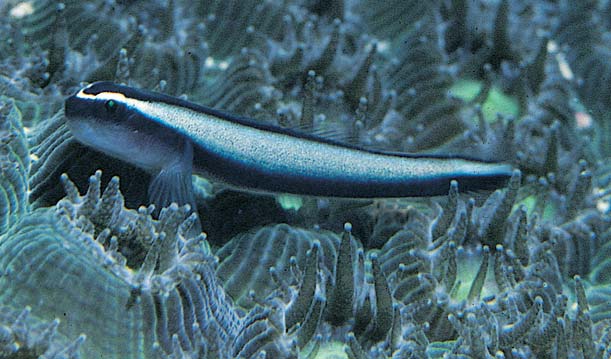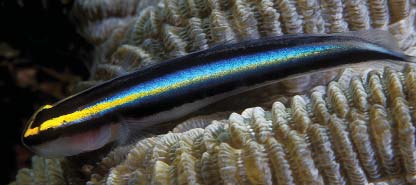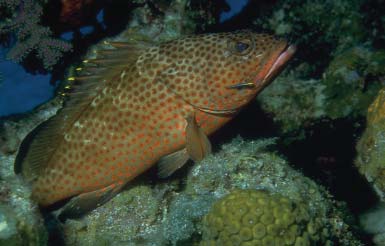Palumbi.stanford.edu



patterns—electric blue in the westernCaribbean, lemon yellow in the Northern
Why Gobies Are Like Hobbits
Bahamas, and stark white in the eastern
Stephen R. Palumbi and Robert R. Warner
Caribbean—might be local signals to preda-tors that these gobies are the valet service
As Bilbo Baggins famously warned, trav- genetic breaks between island groups that rather than the entrée. If this is true, then the
el is an uncertain business: "You step
live relatively close together. These breaks
wrong color pattern of an "immigrant" goby
into the Road, and … there is no know-
coincide with well-established color-pattern
may not be recognized, and so would be
ing where you might be swept off to" (1). For
differences among goby fish—for example,
strongly selected against.
the better part of a century, marine biologists
the white and blue forms in the Caribbean
But within two of the three color areas,
have assumed the roads of ocean currents are
waters around Puerto Rico are genetically
goby populations remain remarkably distinct
just as uncertain, and
distinct populations even though they reside
from island to island, so this explanation can-
that the drifting eggs
within 23 km of each other (see the figure).
Enhanced online at
not suffice. The other possibility is that the
www.sciencemag.org/cgi/ and larvae and rafting
goby larvae manage somehow to
content/full/299/5603/51 propagules of many
avoid dispersing on ocean currents—
marine species end up
that is, they have a hidden level of drift
far from their homes, on distant shores.
control not predicted by most larval
Now, on page 107 of this issue, Taylor and
biologists. Gobies may be particularly
Hellberg (2) help to overturn this notion. They
adept at this because their larvae are
provide further evidence that at least some
often found nearer to shore than are
marine species whose larvae have the potential
the larvae of other reef fishes. But this
to disperse over long distances, instead show
genetic pattern is by no means restrict-
a remarkable fondness for home.
ed to gobies. In fact, gobies join an
During the past 2 years, evidence for
increasing number of island species
this new way of thinking has come
that have fine-scale genetic structures
from two very different sources:
and low dispersal. Mantis shrimp in Indonesia
advanced genetic monitoring of
show genetic differences similar in spatial
widely scattered populations, as
scale and genetic depth to the gobies studied
demonstrated by Taylor and Hellberg
by Taylor and Hellberg
in their new work; and elemental
(4). Fish within closed
analysis of the chemical signatures
Polynesian lagoons are
contained in larval structures (3).
genetically different from
By comparing the genes of indi-
those outside the lagoons
In living color. The white
viduals collected from different
(5). And crabs, fish,
(top) and blue (middle)
places, genetic analysis can help to
oysters, and mussels, a
forms of the cleaner goby
underscore the way in which marine
veritable genetic paella,
fish, Elacatinus (Gobiosoma)
populations move around. Because
show gene-frequency
evelynae. In the Caribbean
every adult or larva or egg that moves
waters around Puerto Rico, the
differences across bio-
carries with it the genes it inherited
white and blue forms of the
geographic boundaries
from its parents, genetic variation can
goby live within 23 km of each
between the Gulf of
serve as a natural tag. Moreover, pop-
other, yet remain genetically separate. Even though their
Mexico and the west Atlantic (6), or between
ulation genetic theory shows that
pelagic larvae could be dispersed over large distances by
the Mediterranean and the east Atlantic (7).
even a small amount of migration
ocean currents, the larvae prefer to remain close to home.
These genetic results are paralleled by new
between populations can wipe out
(Bottom) A cleaner goby (also called a sharknose goby) cleans
information gleaned from the chemical signa-
most genetic differences. So, when
the parasites from a red hind (Epinephelus guttatus).
ture of fish otoliths (calcareous components of
differences emerge from marine
the inner ear) or mollusk statoliths (calcareous
OM) STEPHEN FRINK/CORBIS
genetic data, the implications are strong that
The gobies studied by Taylor and Hellberg
components in the balance organs). These
very little population exchange has taken place.
have high dispersal potential—their larvae
hard structures of calcium carbonate grow like
Just such a conclusion emerges from the
remain adrift in ocean currents for about 3
tiny pearls within the animal, depositing a
Taylor and Hellberg study (2). They show
weeks, a period long enough for drifting
layer for each day of life—including the days
that there are remarkably strong patterns of
buoys to travel hundreds of kilometers (2).
spent as pelagic larvae. As larvae pass through
genetic structure in the mitochondrial genes
Two types of explanations are possible for
different trace-metal environments, the hard
WILK/ REEFNET INC
of a small Caribbean reef goby fish (see the
sharp genetic distinctions in the face of such
parts act as a sort of flight recorder that can be
figure). Such patterns demonstrate not only
dispersal potential. First, there might be
read after the larvae settle in their final loca-
that distant islands harbor genetically distinct
strong selection against the wrong genotypes.
tion. The information thus gleaned differs in
populations, but also that there are sharp
These gobies are cleaners—that is, they make
significant ways from that obtained through
their living picking the parasites off larger
genetic analysis. It reflects an individual's his-
S. R. Palumbi is in the Department of Biological
fish, often the same fish that any rational
tory since birth, including the pelagic pathway
Sciences, Stanford University, Pacific Grove, CA 93950,
goby would consider a dangerous predator.
taken as a larva, and potentially provides much
USA. E-mail: [email protected] R. R. Warner is in
Yet the large fish hold their appetites at bay
more fine-scale spatial data. But the results are
the Department of Ecology, Evolution, and Marine
while the tiny gobies dart about them, picking
Biology, University of California, Santa Barbara, CA
similar to those obtained by genetic analysis.
93106, USA E-mail: [email protected]
their skin clean of parasites. The variable color
For example, populations of fish on tropical
islands are capable of seeding themselves
uncharacteristic in that they are almost all
3. S. E. Swearer et al., Bull. Mar. Sci. 70, 251 (2002).
despite having larvae that survive for weeks
from island populations (9). Yet these exam-
4. P. H. Barber, S. R. Palumbi, M. V. Erdmann, M. K. Moosa,
with the potential for long-distance dispersal
ples of fine-scale patterns in genetic or chem-
Nature 406, 692 (2000).
5. S. Planes, P. Romans, R. Lecomte-Finiger, Coral Reefs
(3). Whelk populations along the California
ical signatures tell us that the conventional
17, 9 (1998).
coast also appear to be colonized by locally
wisdom of marine biology—that the ocean
6. J. C. Avise, Phylogeography (Harvard Univ. Press,
produced larvae (8).
road is a long one for larvae—may prove to be
Cambridge, MA, 2000).
7. H. Quessada, C. Zapata, G. Alvarez, Mar. Ecol. Progr.
These emerging empirical data obtained
a coarse generalization (10). It turns out that
Ser. 116, 99 (1995).
using two very different approaches are telling
most hobbits do not take the long road
8. D. Zacherl, thesis, University of California, Santa
us the same thing: that in some times and
either—Bilbo was an exception—and in the
Barbara (2002).
9. C. Mora, P. F. Sale, Trends Ecol. Evol. 17, 422 (2002).
places, marine larvae are capable of maintain-
end gobies and hobbits like to stay at home.
10. The extent of marine larval dispersal will be one of
ing close links to home despite their proximity
the subjects of a symposium at the upcoming AAAS
to the ocean highways of the sea. Of course,
References and Notes
meeting in Denver, CO: "Opening the Black Box:
1. J. R. R. Tolkien, The Lord of the Rings: The Fellowship
Understanding Ecosystem Dynamics in the Coastal
many other marine species seem to disperse
of the Ring (Houghton Mifflin, Boston, 1994), p. 72.
Ocean" (B. Menge, R. Warner, and J. Lubchenco, co-
broadly, and the examples cataloged here are
2. M. S. Taylor, M. E. Hellberg, Science 299, 107 (2003).
form. Thus, there are 3 C22H28 tetraman-tanes, 6 isomeric C26H32 pentamantanes,and as many as 17 possible C
mantane isomers.
As the number of isomers increases, dif-
Delving into Nature's Bounty
ferences between their relative thermody-namic stabilities decrease, and the com-
plexity of the potential-energy surface con-
necting these isomers increases.
The molecular lattice of diamond, first
Thus, it becomes increasingly
elucidated in 1913 (1), consists of
difficult to promote a smooth
repeating units of 10 carbon atoms
forming a tetracyclic cage system. Shortly
to obtain a single isomer. As the
thereafter it was recognized that a series of
limitations of rearrangement
saturated hydrocarbons can be superim-
synthesis became clear, interest
posed on this diamond lattice. The simplest
in diamondoid hydrocarbons
of these "diamondoids," with the common
waned once again.
name adamantane (from αδαµας, the
In a report by Dahl et al. (5)
Greek word for diamond), is a tricyclic
on page 96, they present results
C10H16 isomer. The series of saturated
that may reawaken interest in
hydrocarbons can then be regarded as
this important class of com-
higher "adamantologs" of adamantane (see
pounds. There are compelling
the figure).
reasons to do so. Substituents
Adamantane and the larger diamon-
can be introduced easily at
doids long remained hypothetical mole-
bridgehead positions of diamon-
cules. They could neither be isolated from
doids (6, 7). Such functionalized
a natural repository, nor made through
diamondoid molecules have
Diamond in miniature. The structures of adamantane
rational organic synthesis. As a result,
important pharmaceutical appli-
(left), diamantane (center), and triamantane (right) are seg-
interest in these molecules and their chem-
cations. Perhaps the most widely
ments of the diamond lattice.
istry remained dormant until 1957, when
known is 1-aminoadamantane
Schleyer reported that endo-trimethyle-
tane (C14H20) (see the figure). This com-
(also known as amantadine or Symmetrel),
nenorbornane (which can be prepared read-
pound—unknown in the literature at the
which is used extensively as an antidyski-
ily) rearranges to adamantane when
time—was chosen as the official emblem
netic to treat parkinsonism and related
refluxed overnight with aluminum bromide
of a 1963 IUPAC conference. In response
extrapyramidal syndromes and as a chemi-
or aluminum chloride (2).
to the implied challenge, Schleyer again
cal antiviral agent to treat Type A influenza
This Lewis acid–catalyzed thermody-
used his "rearrangement synthesis"
in humans (6). Polyalkyladamantanes have
namic rearrangement of hydrocarbons
approach successfully to prepare diaman-
been studied as high–energy-density
afforded a method to prepare adamantane
tane (3). The third member of the dia-
materials, particularly as components of
simply and inexpensively. It led to
mondoid series, C18H24, nicknamed tria-
jet fuel blends (8–10). There is also
renewed interest in the synthesis and
mantane, was isolated and characterized
renewed interest in nanotechnological
chemistry of adamantane and related dia-
shortly thereafter (4).
applications of diamondoid molecules,
mondoid molecules with the chemical for-
As higher diamondoids were sought,
particularly in the area of microelectron-
mula C(4n+6)H(4n+12), where n = 0, 1, 2, 3, …
however, it rapidly became apparent that
ics (11).
The next diamondoid molecule to
the rearrangement synthesis approach has
Dahl et al. (5) have isolated and charac-
become a focus of attention was diaman-
severe limitations. Whereas each of the
terized several previously unknown higher
first three members of the series (adaman-
diamondoid hydrocarbons from crude oil.
tane, diamantane, and triamantane) exists
In addition, they have developed improved
The author is in the Department of Chemistry,
as a single isomer, higher members of the
methods for isolating higher diamondoids
University of North Texas, Denton, TX 76203, USA.
E-mail: [email protected]
series can exist in more than one isomeric
that hold considerable promise for the
Source: http://palumbi.stanford.edu/manuscripts/PalumbiWarner2003.pdf
portal.uacm.edu.mx
NUM 8. MAYO-AGOSTO 2010 BCG: la vacuna más utilizada en el mundo Resistencia bacteriana a los antibióticos: Tuberculosis latente, un modelo de una eficiente respuesta inmune contra Mycobacterium tuberculosis ¿Cómo sobrevive el Mycobacterium sp. en la célula hospedera?
ims.u-tokyo.ac.jp
Research HospitalDepartment of Medicine (Department of Hematology-Oncology) Our department has been challenging to cure a variety of fatalhematological disorders with currently available methods. Themainstay to achieve our goal is, nowadays, hematopoietic stemcells (HSC) including bone marrow, peripheral blood and um-bilical cord blood cells, transplantation and cytokine therapy.These projects have been under way at the HSCT and Hematol-ogy wards with the excellent assistance of nurses andcomedical staffs. We annually take care of more than 40 pa-tients with autologous or allogeneic HSCT. In an attempt toexpand therapeutic benefits of HSCT, we are actively participat-ing to the nation-wide project of unrelated bone marrowtransplantation as the largest HSCT center in Japan. In 1998,we furthermore have established Tokyo cord blood bank ser-vices in our hospital. Cord blood cell transplantation hasbecome strong weapon for patients sufferred from hematolog-ical malignancy without any related or unrelated stem celldonors. We have already treated more than 25 adult patientsuntil the end of March, 2001. Also since 1998, we had startedclinical gene therapy for stage IV renal cancer patients as col-laboration with other clinical departments in our hospital aswell as other hospitals including Juntendo University Hospital,Tsukuba University Hospital, and National Cancer Center.